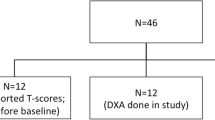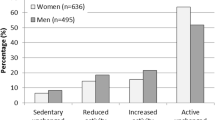Abstract.
In order to evaluate the contribution of habitual physical activity to bone remodeling, we determined bone mineral density (BMD) at the lumbar spine (L2–4) and the hip by dual energy X-ray absorptiometry in 55 clerks and 44 nurses. Our data indicate similar L2–4 BMD in both groups due to equal weight load of the upper part of the body on the spinal column in both study groups, but higher femur BMD in the nurse group (0.6–0.8 SD, at various hip measurement sites) than in the clerk group. The age-adjusted hip BMD was correlated with serum osteocalcin levels, and was related to the duration of standing at work, indicating a cause and effect relationship. We conclude that prolonged working in a sitting position may induce a low hip BMD, and thereby increase the risk for osteoporotic hip fracture.
Similar content being viewed by others

Author information
Authors and Affiliations
Additional information
Received: 2 December 1996 / Accepted: 3 September 1997
Rights and permissions
About this article
Cite this article
Weiss, M., Yogev, R. & Dolev, E. Occupational Sitting and Low Hip Mineral Density. Calcif Tissue Int 62, 47–50 (1998). https://doi.org/10.1007/s002239900393
Published:
Issue Date:
DOI: https://doi.org/10.1007/s002239900393



